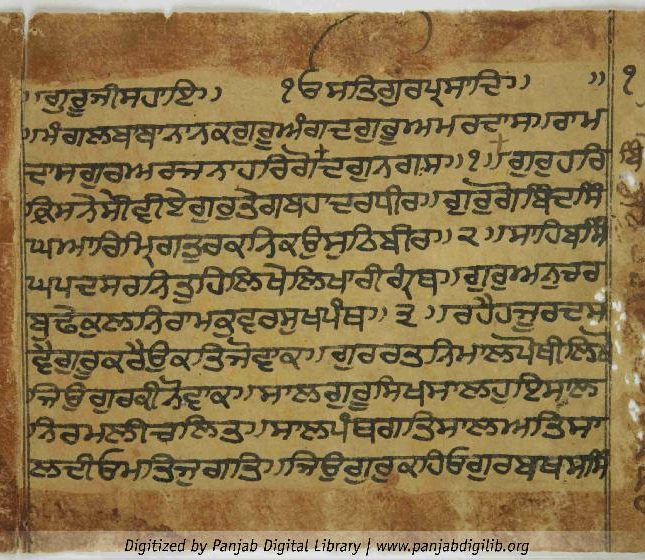Panj Sau Sakhi, a collection of five hundred anecdotes (panj=five; sau=hundred; sakhi = anecdote), attributed to Bhai Ram Kuir (1672-1761), a descendant of Bhai Buddha, renamed Bhai Gurbakhsh Singh as he received the rites of the Khalsa at the hands of Guru Gobind Singh (1666-1708). It is said that during his long association with the Guru, Ram Kuir had heard from his lips many anecdotes concerning the lives of the Gurus which he used to narrate to Sikhs after his return to his village, Ramdas, in Amritsar district, after Anandpur had been evacuated in 1705. Bhai Sahib Singh is said to have reduced these sakhls to writing.
Later, they were split into five parts, each comprising one hundred stories whence the title “Sau Sakhi” or A Hundred Stories gained currency.These five sections were distributed among Bhai Sahib Singh, the scribe, Kabull Mall, Multani Sura, Ratia, and Surat Singh of Agra. Giani Gian Singh, author of the Panth Prakash, is said to have seen two manuscripts of this work—one with a mahant (priest) of Name da Kot and another with Shiv Ram Khatri of Agra.
Bhai Kahn Singh of Nabha also seems to have had access to a manuscript copy. None of these manuscripts, much less an authentic printed version, is however available today. The authors of the Gurbilas and Sri Gur Pratap Suraj Granth seem to have drawn upon these anecdotes which are more legendary than historical in character.
References :
1. Bedi, Tarlochan Singh, Punjabi Varkak da Alochanatmak Adhyyan, Delhi, 1972.
2. Gurmukh Singh, Sevapanthian di Punjabi Sahit nun Den. Patiala, 1986.
3. Kohli, S.S. (ed.), Puratan Punjabi Vartak Chandigarh, 1973.
Panj Sau Sakhi: A Legendary Compilation of 500 Sikh Anecdotes
The Panj Sau Sakhi is a storied anthology in Sikh tradition—a collection of five hundred anecdotal narratives that illuminate the lives, miracles, and teachings of the Gurus. Cherished for its cultural significance and spiritual insights, this compilation represents one of the most evocative repositories of early Sikh lore.
Origins and Compilation
Attributed to Bhai Ram Kuir (1672–1761), a descendant of Bhai Buddha who later became known as Bhai Gurbakhsh Singh upon receiving the rites of the Khalsa from Guru Gobind Singh, the Panj Sau Sakhi is said to have its beginnings in oral tradition. During his long association with Guru Gobind Singh, Bhai Ram Kuir is believed to have absorbed numerous anecdotes recounting the divine exploits and everyday wisdom of the Gurus. After the tumultuous evacuation from Anandpur in 1705, he reportedly recounted these stories to fellow Sikhs in his native village of Ramdas in the Amritsar district.
Over time, these oral tales were committed to writing—credited to Bhai Sahib Singh, who is said to have reduced them to text. The narratives were later organized into five sections, each containing one hundred stories. This division not only gave rise to the title “Sau Sakhi” (a hundred stories) but also underscored the systematic effort to preserve the legendary exploits, which continue to inspire devotion and cultural pride among Sikhs today.
Cultural and Spiritual Significance
Though the anecdotes within Panj Sau Sakhi lean more toward the legendary than the historically verifiable, they are imbued with spiritual symbolism and moral lessons that reflect the ethos of early Sikh thought. The stories reveal:
- Miraculous Episodes and Divine Interventions: Many sakhis recount miraculous happenings, signifying the divine favour that Guru Nanak and subsequent Gurus enjoyed. These narratives not only validate the spiritual authority of the Gurus in the eyes of devotees but also serve as allegories for the transformative power of faith.
- Ethical Exhortations and Life Lessons: Beyond their miraculous elements, the anecdotes frequently contain moral exhortations—teaching lessons on truth, compassion, and sacrifice. They echo the core message of Sikhism: that personal integrity and an unwavering commitment to the divine path are the foundations of a righteous life.
- A Reflection of Community Identity: As a collective memory of the early Sikh community, Panj Sau Sakhi helped forge a shared identity amongst believers at a time when personal contact with the Gurus was increasingly rare. The narratives provided a substitute for direct experience, reinforcing communal bonds through the recitation of revered tales.
Manuscript History and Legacy
Despite its cultural importance, no authenticated printed version of Panj Sau Sakhi survives today. Historical accounts suggest that several manuscript copies existed and circulated among Sikh communities—with notable collections reported in Agra and other hubs of Sikh literary activity. Giani Gian Singh, the author of the Panth Prakash, is said to have seen more than one manuscript of this work. Over time, however, these manuscripts have either been lost or remain in private or inaccessible collections. Nonetheless, the influences of Panj Sau Sakhi are evident in later Sikh compositions, such as those found in the Gurbilas narratives and the Sri Gur Pratap Suraj Granth, where the legendary material was reshaped into new literary forms.



